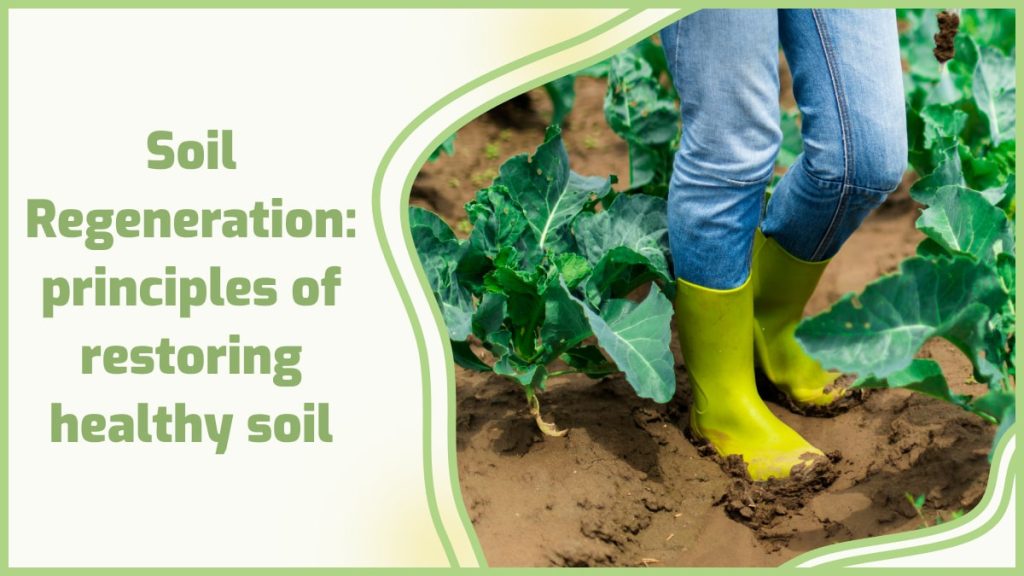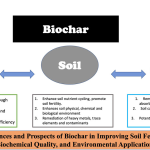Is your soil looking tired and worn out after the harvest season? You’re not alone.
Many farmers and gardeners face the challenge of depleted soil, which can impact future yields and the overall health of your crops. But don’t worry—there are effective solutions to breathe new life into your soil. Imagine boosting your soil’s vitality, ensuring that your next planting season is even more bountiful.
This could mean healthier plants, more robust produce, and ultimately, a more successful harvest. We’ll uncover the best practices for soil rejuvenation after harvest, equipping you with the know-how to transform your soil into a thriving foundation for growth. Ready to learn the secrets of soil success? Let’s dig in!

Soil Assessment Techniques
Effective soil assessment involves analyzing nutrient levels and pH balance for optimal soil rejuvenation post-harvest. Regular testing ensures sustainable farming practices, enhancing soil health and crop productivity. Employing best practices helps maintain soil vitality, supporting future harvests.
Rejuvenating soil after harvest is crucial for sustainable farming. Understanding your soil’s current state is the first step. Soil assessment techniques help you determine what your soil needs to thrive again. This process involves simple tests and observations that can make a big difference in your soil health. Let’s dive into practical methods to assess your soil effectively.Soil Texture Analysis
Understanding soil texture is vital. It helps you know how much sand, silt, and clay is present. Feel the soil in your hands. Is it gritty or smooth? A simple jar test can reveal the percentage of each component. Add soil to water in a jar, shake it, and let it settle. You’ll see clear layers form. This tells you about drainage and nutrient retention abilities.Ph Testing
Testing soil pH is straightforward yet powerful. It influences nutrient availability and microbial activity. Use a pH meter or litmus paper. Aim for a pH between 6 and 7 for most crops. If it’s off, lime can raise pH, while sulfur can lower it. Think of pH like a thermostat for your soil’s environment.Organic Matter Content
Organic matter is your soil’s life source. It improves structure, water retention, and nutrient supply. Check the color and smell of your soil; darker and earthy-smelling soil usually has more organic matter. Consider composting or adding cover crops to boost levels. Reflect on how a small addition can lead to a thriving garden.Soil Compaction Check
Compact soil restricts root growth and water movement. Push a pencil or metal rod into the ground. If it’s hard to penetrate, your soil might be compacted. Aeration and tilling can alleviate compaction. Imagine your plants breathing easier with looser soil around them.Biological Activity Observation
Observe the life within your soil. Look for earthworms and microbial activity. These are indicators of healthy soil. They break down organic matter, making nutrients available. If you see few signs of life, consider adding organic amendments. Envision a bustling community under your feet that supports robust plant growth. Soil assessment is about getting to know your soil intimately. Which technique will you try first? Each method offers unique insights, helping you make informed decisions for soil rejuvenation. So, grab your tools and start exploring your soil’s secrets today.
Organic Matter Integration
Organic matter integration is vital for soil rejuvenation post-harvest. This practice enriches the soil with necessary nutrients, improving its overall health. Without replenishing organic matter, soil loses its fertility over time. Farmers and gardeners must understand the importance of returning organic materials to the soil. It enhances soil structure, boosts microbial activity, and increases water retention.
Understanding Organic Matter
Organic matter includes decomposed plant and animal residues. It is essential for maintaining soil health. Decomposition releases nutrients that plants need for growth. This process also improves soil’s ability to hold water and nutrients. Regular addition of organic matter helps in maintaining soil fertility.
Composting: A Sustainable Approach
Composting is an effective way to integrate organic matter. It involves collecting plant waste and letting it decompose. This creates a nutrient-rich amendment for the soil. Compost improves soil structure and increases microbial activity. It also helps in reducing waste and supports sustainable farming practices.
Green Manures And Cover Crops
Green manures and cover crops are plants grown to improve soil health. They are not harvested for sale. Instead, they are tilled back into the soil. This practice adds organic matter and enhances soil fertility. Cover crops also prevent soil erosion and suppress weeds.
Mulching To Preserve And Enrich
Mulching involves covering the soil with organic materials. This layer retains moisture and prevents erosion. As mulch breaks down, it adds organic matter to the soil. Common mulching materials include straw, grass clippings, and bark chips. Mulching helps regulate soil temperature and reduces weed growth.
Animal Manure: An Age-old Practice
Animal manure is rich in nutrients and helps improve soil structure. It must be well-composted before application to avoid pathogens. Manure increases organic matter content and enhances soil microbial life. Using manure supports sustainable agriculture by recycling farm waste.
Nutrient Management Strategies
Enhancing soil health after harvest involves rotating crops and adding organic matter like compost. These practices help restore essential nutrients. Testing soil regularly ensures balanced nutrient levels, promoting healthy crop growth in future seasons.
Managing nutrients effectively is crucial for rejuvenating soil after harvest. Without proper care, soil can lose its fertility, affecting future crops. By focusing on nutrient management strategies, you can restore and maintain soil health.Soil Testing And Analysis
Testing your soil is the first step. It helps you understand what nutrients are missing. You can then plan how to add them back. Regular soil tests guide your nutrient management strategy. This ensures you’re not wasting resources. Plus, it avoids over-fertilization, which can harm the environment.Organic Matter Addition
Adding organic matter is like giving your soil a vitamin boost. Compost, manure, and plant residues enrich the soil with nutrients. They also improve soil structure and water retention. Think about last year’s garden waste. Instead of discarding it, compost it. It’s a simple way to recycle nutrients back into your soil.Cover Crops
Cover crops are a fantastic option for soil rejuvenation. They prevent erosion and suppress weeds. More importantly, they fix nitrogen in the soil. Imagine your soil getting a rest while cover crops do the hard work. Once tilled back into the soil, they increase organic matter content.Balanced Fertilization
Balance is key in fertilization. Use fertilizers that provide nutrients your soil lacks. Too much of one nutrient can cause deficiencies in others. Have you ever added too much fertilizer, only to see poor plant growth? A balanced approach prevents such issues, ensuring healthy crops.Crop Rotation
Crop rotation is an age-old practice that still works wonders. It prevents nutrient depletion and breaks pest cycles. By changing crops annually, you give your soil a chance to recover. Have you considered rotating legumes with grains? This simple switch can make a big difference in nitrogen levels in your soil.Precision Agriculture
Precision agriculture uses technology to manage soil nutrients. Tools like GPS and sensors help apply nutrients exactly where needed. This reduces waste and boosts efficiency. Imagine saving money and enhancing soil health at the same time. Precision techniques offer a modern solution to age-old farming challenges. Are you ready to implement these strategies? Each one offers unique benefits that can help rejuvenate your soil after harvest. Which will you try first?
Cover Cropping Benefits
Cover cropping is a sustainable method to rejuvenate soil after harvest. This practice offers numerous benefits that enhance soil health and productivity. By planting cover crops, farmers can protect and enrich their soil. These crops provide essential nutrients and improve soil structure. They play a crucial role in maintaining farm sustainability.
Environmental Protection
Cover crops reduce soil erosion and nutrient runoff. They act as a natural barrier against wind and water. This protection helps preserve the soil’s top layer. By doing so, they maintain soil fertility and structure.
Improved Soil Fertility
Cover crops like legumes fix nitrogen in the soil. This natural process adds essential nutrients back into the earth. It reduces the need for synthetic fertilizers. As a result, farmers save on costs while boosting soil health.
Weed Suppression
Cover crops compete with weeds for sunlight and nutrients. This competition limits weed growth in the fields. Farmers face fewer weed-related challenges. Thus, leading to less reliance on chemical herbicides.
Enhanced Soil Structure
Cover crops improve soil aeration and water retention. Their roots break up compacted soil layers. This improvement allows for better water infiltration. It also enhances root growth for future crops.
Biodiversity Boost
Cover crops support diverse ecosystems within the soil. They attract beneficial insects and microorganisms. This biodiversity strengthens the soil’s resilience. Healthy soil leads to healthier crops.
Conclusion
Soil health matters for future harvests. Implementing best practices ensures fertile ground. Rotate crops to reduce nutrient depletion. Use organic matter like compost to enrich the soil. Avoid chemical overload by choosing natural fertilizers. Regular testing helps maintain soil balance.
These steps foster robust growth and yield. Farmers benefit from improved soil quality. Healthy soil leads to healthy plants. Protecting the soil today secures food for tomorrow. Embrace sustainable techniques and watch your fields thrive. Your efforts will nurture the earth and sustain agriculture.



